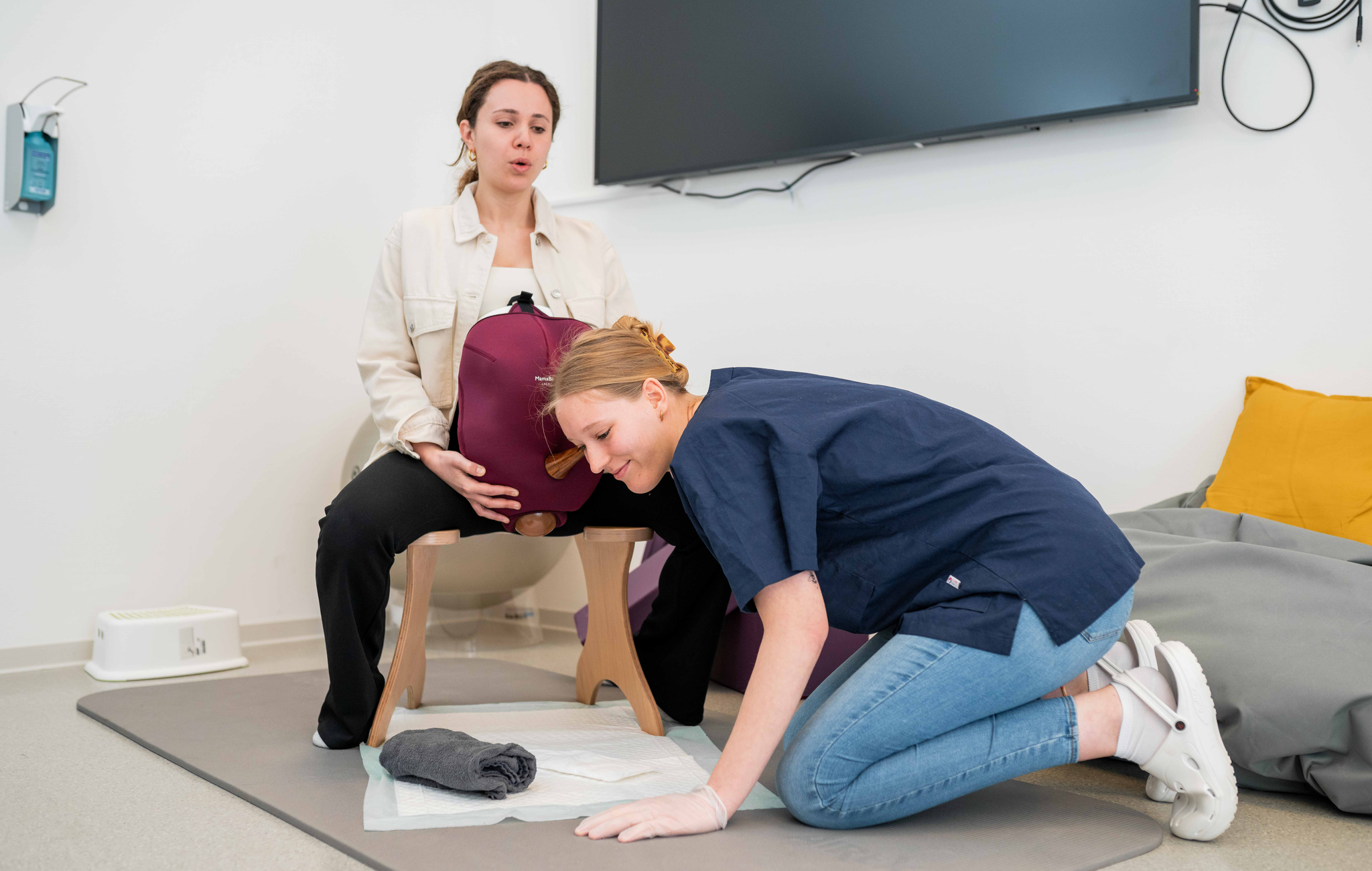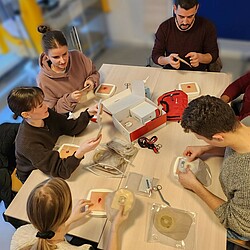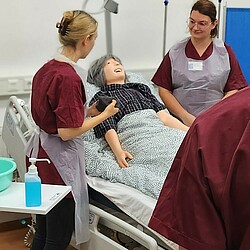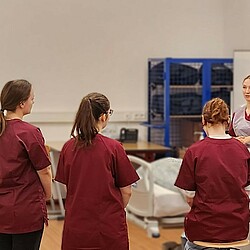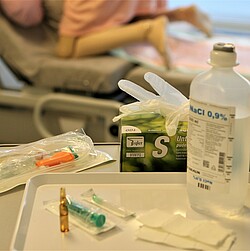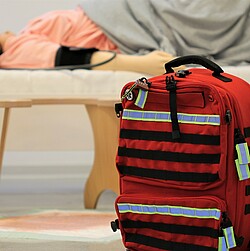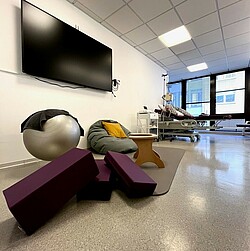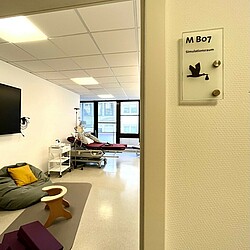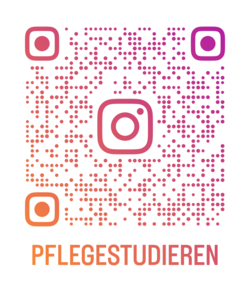Skills lab for midwives and nurses
Midwives and nurses need comprehensive knowledge for their responsible work, but also routine in the actions that they have to perform on a daily basis or only in an emergency.
Confidence is gained through regular practice. The confidence you gain also leads to greater safety in patient care and protects them from incorrect treatment.
In our skills and simulation center, important skills and abilities for everyday professional situations are trained in realistically designed rooms.
In addition to the learning locations "theory" (university) and "practice" (clinical and outpatient settings), the third learning location "Skillsand Simulation Center" enables practical skills to be trained before they are used in practice on real people.
Learning methods
After acquiring important theoretical knowledge in lectures and seminars, the associated skills and abilities are trained in the skills and simulation center. These are deepened and expanded in subsequent practical assignments. Experiences from the practical assignments are also reflected on in the skills and simulation training. This allows students to further develop their own skills and transfer them to different situations.
The skills and simulation center uses skills training and simulation as learning methods, which are anchored in the didactic concepts of both degree programs and build on each other semester by semester.
It is important to us that students first master the skills before linking them to chains of action in case studies and simulations and applying them to specific situations .
Knowledge and complexity increase as the course progresses and our methods adapt to this .
Skills training
Skills trainingrefers to the learning and training of individual skills and abilities that are required to perform an action correctly. Using the cognitive apprenticeship method, individual actions are trained and reflected on in small groups with the help of action plans and checklists.
Simulation
During the simulation, complex situations are practiced and reflected upon. This enables learners to learn how to act in different situations and further develop their skills. The situations are based on real-life professional situations. In addition to the skills of individual learners, teamwork can also be practiced, e.g. in emergency situations.
In the simulation, either fellow students, simulation persons or simulators & models (e.g. a full-body mannequin or body parts) can be used in the role of the patient.
The simulation follows a fixed structure. In the run-up to the actual simulation, all participants are trained about the situation to be simulated and their roles. This is followed by the actual simulation of the professional situation. (Gabler, 2019, cited in Schlegel et al. 2020). Following the simulation, the simulation is debriefed and the resulting insights are jointly developed and transferred to practical action (Schlegel et al., 2020).
As a rule, the simulation training takes place following or building on the skills training, so that the learners first practice core skills and then use these skills and existing knowledge to master complex and highly complex case situations.
The debriefing of the simulations always follows a predefined structure so that students and educators can focus on the content in order to gain the greatest possible benefit from the simulation.
Goals
The Simulation Network for Education and Training in Nursing (SimNAT Pflege) specifies the following objectives for learning in skills and simulation training:
- Enabling the acquisition of skills, abilities and knowledge in a risk-free and anxiety-free learning environment and gaining confidence in one's own actions
- Improvement of professional competence
- Promoting the safety of patients (Loewenhardt et al. 2014, 65 cited in Sander, 2017, p. 3)
Interprofessionalism
At the Ludwigshafen University of Business and Society (HWG), the training takes place in a skills and simulation center for the primary qualifying degree programs in midwifery and nursing. This joint use also opens up potential spaces for interdisciplinary training and thus promotes interprofessional exchange.
It is important to us that our education staff have the appropriate professional qualifications as midwives, in nursing or medicine and that they also have the appropriate pedagogical teaching qualifications and experience in this field in addition to their professional experience.
We also regularly undergo further professional and pedagogical training - e.g. as part of the CRM simulation instructor training or on the use of other digital methods.
Rooms ground floor
Current: We are aiming for bigger things and are moving to new premises near our main campus for the winter semester - even more rooms, equipment and technology. We are already very excited!
Room MA02
The spacious room serves as the main area in our skills and simulation center. Most of the skills training for both degree programs takes place here. Due to its size, this room can be designed and used in a variety of ways. Two beds from the long-term care setting are also located here.
Hallway
We are currently working with care dolls in the area of personal care and also to create settings - both for newborns and adults. And everyone finds their place, like here - derived from the care of people with dementia - at our bus stop.
Room MA01
There is also a room on the first floor that offers a clinical setting with 3 beds. Skills training and simulations can be carried out here, e.g. as part of basic and treatment care or postnatal care.
Rooms upstairs
Multifunctional room
The spacious multifunctional room can be used in a variety of ways. Thanks to the technical equipment, theoretical and practical education can take place in this room. The identically structured care units in all rooms offer students the opportunity to find their way around and start their training in a well-organized manner.
In addition to a crib in which the "Junior nursing doll" lies, there is also a fully electric hospital bed in this room. This room is therefore suitable for creating a clinical setting in the training sessions. Juno" is also always used here in the training sessions. The high-fidelity simulator offers the opportunity to carry out clinical assessments and measures as part of diagnostics, but also during simulations.
Simulation circle room
The delivery room is mainly used by the Midwifery Science degree programs. The room offers the opportunity to simulate various obstetric situations and is equipped accordingly
Hanna" can often be found in this room. "Hanna" is a high-fidelity doll that can be used to practice external examinations during pregnancy, perform a vaginal examination and simulate birth in various positions.
A patient monitor can be used to simulate a CTG and various vital signs of mother and child.
Domesticity
The home is particularly suitable for skills and simulation training that takes place in an outpatient setting, for example for outpatient care or postnatal care at home. Aids such as a bed rope ladder or a fall mat can also be found here.
Skills and simulation center in action
Here you can see some pictures of skills and simulation training from both degree programs.
Interprofessional cooperation is very important to us in the degree programs, which is why some training courses are designed to be interprofessional. For example, in the first and third semesters of nursing, the topic of breastfeeding is taught by an education specialist from the midwifery course during training on nutrition management and pediatrics.
Resuscitation training for both degree programs is provided jointly by an education specialist from the nursing degree program.
To get more insights into our degree programs, you are welcome to follow us on Instagram.
